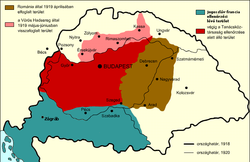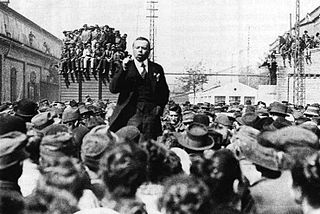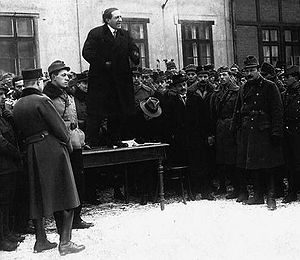- Hungarian Soviet Republic
-
Not to be confused with People's Republic of Hungary.
Hungarian Soviet Republic
Magyarországi Tanácsköztársaság← 
1919  →
→
 →
→

Flag Emblem Map of territory claimed by Hungary, May – August 1919
Territory controlled by Romania in April, 1919Territory controlled by HungaryTerritory subsequently controlled by HungaryTerritory under French and Serb controlPre-WW1 Borders of Hungary, 1918Post-WW1 Borders of Hungary, 1920Capital Budapest Language(s) Hungarian Government Socialist Republic Leader of the Revolution - 1919 Béla Kun Chairman of the Revolutionary Governing Council - 1919 Sándor Garbai - 1919 Gyula Peidl Legislature National Assembly Historical era Interwar Period - Established 21 March 1919 - Disestablished 6 August 1919 The Hungarian Soviet Republic or Soviet Republic of Hungary (Hungarian: Magyarországi Tanácsköztársaság) was a short-lived Communist state established in Hungary in the aftermath of World War I.
Lasting only from 21 March until 6 August 1919, the republic led by Béla Kun collapsed when Romanian forces occupied Budapest during the Hungarian-Romanian War. It was the first Communist government to be formed in Europe after the October Revolution in Russia brought the Bolsheviks to power. The successor to the state was the Kingdom of Hungary, which was formed after the Romanian Army pulled out of Hungary.
Contents
Formation
As the Austro-Hungarian Monarchy collapsed in 1918, an independent Hungarian Democratic Republic was formed after the Aster Revolution. Official proclamation of the republic was on 16 November 1918 and its president became Mihály Károlyi. Károlyi struggled to establish the government's authority and to control the country.
An initial nucleus of a Hungarian communist party had been organized in a Moscow hotel on 4 November 1918, when a group of Hungarian prisoners of war and other communist proponents formed a Central Committee. Led by Béla Kun, the first members returned to Hungary, and on 24 November created the The Party of Communists from Hungary (Kommunisták Magyarországi Pártja) and recruited members while propagating party's ideas, radicalising many Social Democrats in the process. By February 1919, the party numbered 30,000 to 40,000 members, including many unemployed ex-soldiers, young intellectuals and ethnic minorities.[1]
The Communist party chose its title instead of "Magyar Kommunista Párt" (Hungarian Communist Party). The Communists came to power as the only group with an organised fighting force, promising Hungary would be able defend its territory without conscription. (Kun promised the military help of the Soviet Red Army against Romanian, Czechoslovak and Yugoslav forces - none of whom were communist then).
History of Hungary 
This article is part of a seriesPrehistory Prehistoric Pannonia Prehistoric Magyars Early history Roman Pannonia Magyar invasion Middle Ages (896–1541) Principality of Hungary
(896–1000)Medieval Kingdom of Hungary
(1000–1538)Turkish wars
(1366–1526)Early Modern history Habsburg Kingdom of Hungary
(1538–1867)Eastern Hungarian Kingdom
(1538–1570)Ottoman Hungary
(1541–1699)Principality of Transylvania
(1570–1711)Late modern period Rákóczi's War
(1703–1711)Revolution of 1848 Austria-Hungary
(1867–1918)Lands of the Crown of Saint Stephen Hungary in World War I Interwar period
(1918–41)Kingdom of Hungary
(1920-1946)World War II Contemporary history
(1946 to present)Republic of Hungary
(1946–49)People's Republic
(1949–89)Revolution of 1956 Republic of Hungary
(since 1989)Topical Church history Military history Music history Jewish history Székely people
Hungary Portal
Kun founded a newspaper, called Vörös Újság ('Red News'), and concentrated on attacking Károlyi's government. During the following months, the Communist Party's power-base rapidly expanded. Their supporters began to stage aggressive demonstrations against the media. In one crucial incident, a demonstration turned violent on 20 February and the protesters attacked the editorial office of the Social Democrats' official paper, called Népszava (People's Word). In the ensuing chaos, seven people—including policemen—were killed. The government arrested the leaders of the Communist party,[1] banned Vörös Újság and closed down the party's buildings. The arrests were particularly violent, with police officers openly beating the communists. This resulted in a wave of public sympathy for the Communist Party. On 1 March, Vörös Újság was given permission to publish again, and the Communist Party's premises were re-opened. The leaders were permitted to receive guests in their prison, which allowed them to keep up with political affairs.
On 20 March Károlyi announced that the Dénes Berinkey government would resign. On 21 March he informed the Council of Ministers that only the Social Democrats could form a new government, as they were the party with the highest public support. In order to form a governing coalition, the Social Democrats started negotiations with the Communist leaders—who were still imprisoned—and decided to merge their two parties under the name of Hungarian Socialist Party.[2] For the Social Democrats, an alliance with the KMP not only increased their standing with the common people, but also gave them a potential link to the increasingly powerful Russian Communist Party, as Kun had ties with prominent Russian Bolsheviks. President Károlyi, who was an outspoken anti-Communist, was not informed about the fusion of the parties. Thus, while believing to have appointed a Socialist government, he found himself faced with one dominated by Communists.
Communist policies
Following Lenin's model, but without the direct participation of the workers' councils (soviets) from which it took its name, the newly-united Socialist Party created a government called the Revolutionary Governing Council, which proclaimed the Hungarian Soviet Republic and dismissed President Károlyi on 21 March. This government consisted of a Socialist-Communist coalition, but with the exception of Kun, all commissars were former Social Democrats.[3] The government was led by Sándor Garbai, but Kun, as Commissar of Foreign Affairs, held the real power. Under Kun, the new government, which had adopted in full the program of the Communists, decreed the abolition of aristocratic titles and privileges, separation of church and state, and codified freedom of speech and assembly, free education, language and cultural rights to minorities (the last of which, at least, was not implemented in practice).[1]
The Communist government also nationalized industrial and commercial enterprises, and socialized housing, transport, banking, medicine, cultural institutions, and all landholdings of more than 40 hectares. These economic policies created high inflation while leading to food shortages across the land. Public support for Communists was also heavily dependent on their promise of restoring Hungary's imperial borders.[1] The government took steps toward normalizing foreign relations with the Triple Entente powers in an effort to gain back some of the land that Hungary was set to lose in the post-war negotiations.
 Leaders of the Hungarian Soviet Republic. Tibor Szamuely, Béla Kun, Jenő Landler. Monument in Budapest.
Leaders of the Hungarian Soviet Republic. Tibor Szamuely, Béla Kun, Jenő Landler. Monument in Budapest.
In a radio dispatch to the Russian SFSR, Kun informed Lenin that a "dictatorship of the proletariat" had been established in Hungary and asked for a treaty of alliance with the Russian SFSR.[1] The Russian SFSR refused because it was itself tied down in the Russian Civil War. The Hungarian government was thus left on its own, and a Red Guard was established under the command of Mátyás Rákosi.
In addition, a group of 200 armed men—known as the Lenin Boys—formed a mobile detachment under the leadership of József Cserny. This detachment was deployed at various locations around the country where counter-revolutionary movements were suspected to operate. The Lenin Boys, as well as other similar groups and agitators, killed and terrorised many people (e.g. armed with hand grenades and using their rifles' butts they disbanded religious ceremonies).[4] They executed victims without trial.[5] This caused a number of conflicts with the local population, some of which turned violent.
Downfall
See also: Revolutions and interventions in Hungary (1918–1920)See also: Hungarian–Romanian War of 1919 During the Hungarian Soviet Republic in 1919, the Heroes Square of Budapest was completely covered by red textile and at the basement of the obelisk a new statue was erected: Marx with a worker and a peasant. The statues of Hungarian national heroes were toppled.[6] Hungarian national symbols were banned, and many Hungarian historic monuments were destroyed in the name of internationalism.
During the Hungarian Soviet Republic in 1919, the Heroes Square of Budapest was completely covered by red textile and at the basement of the obelisk a new statue was erected: Marx with a worker and a peasant. The statues of Hungarian national heroes were toppled.[6] Hungarian national symbols were banned, and many Hungarian historic monuments were destroyed in the name of internationalism.
In late May, after the Entente military representative demanded more territorial concessions from Hungary, Kun attempted to fulfill his promise to restore Hungary's borders. At some point in June, the Hungarian Red Army invaded the eastern part of the newly-forming Czechoslovak state (today's Slovakia), then controlled by Czechoslovak forces and declared a Slovak Soviet Republic in Prešov on 16 June 1919. The Hungarian Red Army achieved some military successes: under the lead of Colonel Aurél Stromfeld, it ousted Czech troops from the north, and planned to march against the Romanian army in the east. Despite initial military success, however, Kun withdrew his troops about three weeks later when the French promised the Hungarian government that Romanian forces would withdraw from the Tiszántúl. This concession shook his popular support. Following the Red Army's retreat from the north, the Romanian forces were not pulled back.
The situation of the Hungarian Communists began to deteriorate when, after a failed coup by the Social Democrats on 24 June, the new Communist government of Antal Dovcsák resorted to large-scale reprisals. Revolutionary tribunals ordered executions of people who were suspected of having been involved in the attempted coup. This became known as the "Red Terror", and greatly reduced domestic support for the government.
The Hungarian Soviet found it increasingly difficult to fight Czechoslovakia and later Romania with the small volunteer force, and support for both the war and the Communist Party was waning at home, partly due to the most dedicated Communists having volunteered for combat.
Kun then unsuccessfully turned the Hungarian Red Army on the Romanians, who broke through the weak Hungarian lines on 30 July.
Béla Kun together with other high-ranking Communists fled to Austria on 1 August[1] with only a minority, including György Lukács, the former Commissar for Culture and noted Marxist philosopher, remaining to organise an underground Communist Party.[7] The Budapest Workers' Soviet elected a new government, headed by Gyula Peidl, which only lasted a few days before Romanian forces entered Budapest on 6 August, putting an end to the Hungarian Soviet Republic.[8][9][10]
In the power vacuum created by the fall of the Soviet Republic and the presence of the Romanian Army, semi-regular detachments (technically under Horthy's command, but mostly independent in practice) initiated a campaign of violence against Communists, leftists and Jews, known as the White Terror.[11] Many supporters of the Hungarian Soviet Republic were executed without trial; others, including Péter Ágoston, Ferenc Bajáki, Dezső Bokányi, Antal Dovcsák, József Haubrich, Henrik Kalmár, József Kelen, György Nyisztor, Sándor Szabados, and Károly Vántus, were imprisoned by trial ("comissar suits"). Most of them were later released to the Soviet Union by amnesty during the reign of Horthy, after a prisoner exchange agreement between Hungary and the Russian Soviet government in 1921. In all, about 415 prisoners were released as a result of this agreement.[12] Kun himself and an unknown number of other Hungarian communists were executed during the Great Purge of the late 1930s.[1]
See also
- Tibor Szamuely
- Aftermath of World War I
- Revolutions of 1917–23
- Hungarian Revolution of 1956
- Red Terror
- Red Terror (Hungary)
- Slovak Soviet Republic
References
- ^ a b c d e f g The Library of Congress Country Studies – Hungarian Soviet Republic
- ^ Borsanyi, Gyorgy, The life of a Communist revolutionary, Bela Kun, translated by Mario Fenyo; Social Science Monographs, Boulder, Colorado; Columbia University Press, New York, 1993, p178.
- ^ Janos, Andrew C. & Slottman, William (editors) Revolution in perspective: essays on the Hungarian Soviet Republic of 1919, Center for Slavic and East European Studies, University of California, Berkeley, 1971, p68
- ^ Kodolányi, János (1979) [1941] (in Hungarian). Süllyedő világ. Budapest: Magvető. ISBN 9789632709352. OCLC 7627920.
- ^ See resources in the article Red Terror.
- ^ http://www.youtube.com/watch?v=9smq580awFg&feature=related
- ^ Borsanyi, Gyorgy, The life of a Communist revolutionary, Bela Kun, translated by Mario Fenyo; Social Science Monographs, Boulder, Colorado; Columbia University Press, New York, 1993, p205.
- ^ "Magyar Tudomány 2000. január". Epa.niif.hu. http://epa.niif.hu/00700/00775/00014/109-113.html. Retrieved 2008-11-21.
- ^ Ignác Romsics: Magyarország története a XX. században, 2004, p. 134
- ^ "Hungary: Hungarian Soviet Republic". Library of Congress Country Studies. September 1989. Republished at geographic.com. http://www.workmall.com/wfb2001/hungary/hungary_history_hungarian_soviet_republic.html. Retrieved 7 October 2010.
- ^ ""White Terror" in Hungary 1919-1921". Armed Conflict Events Database. 16 December 2000. http://www.onwar.com/aced/data/hotel/hungary1919b.htm. Retrieved 7 October 2010.
- ^ 2000 - BŰN ÉS BŰNHŐDÉS
Further reading
- Borsanyi, Gyorgy The life of a Communist revolutionary, Bela Kun translated by Mario Fenyo, Boulder, Colorado : Social Science Monographs ; New York: Distributed by Columbia University Press, 1993.
- International Communist Current. "The example of Russia 1917 inspired the workers in Hungary".
- Janos, Andrew C. & Slottman, William (editors) Revolution in perspective : essays on the Hungarian Soviet Republic of 1919: Published for the University of California, Berkeley, Center for Slavic and East European Studies, Berkeley, California: University of California Press, 1971.
- Menczer, Bela "Bela Kun and the Hungarian Revolution of 1919" pages 299-309 Volume XIX, Issue #5, May 1969, History Today History Today Inc: London, United Kingdom.
- Pastor, Peter, Hungary between Wilson and Lenin : the Hungarian revolution of 1918–1919 and the Big Three, Boulder, Colorado: East European Quarterly ; New York : distributed by Columbia University Press, 1976.
- Szilassy, Sándor Revolutionary Hungary, 1918–1921, Astor Park. Florida, Danubian Press 1971.
- Tokes, Rudolf Béla Kun and the Hungarian Soviet Republic : the origins and role of the Communist Party of Hungary in the revolutions of 1918–1919 New York : published for the Hoover Institution on War, Revolution and Peace, Stanford, California, by F.A. Praeger, 1967.
- Volgyes, Ivan (editor) Hungary in revolution, 1918–19 : nine essays Lincoln : University of Nebraska Press, 1971.
- Woods, Alan. "The Hungarian Soviet Republic of 1919: The Forgotten Revolution". 12 November 1979.
Categories:- Former countries in Europe
- States and territories established in 1919
- States and territories disestablished in 1919
- Communism in Hungary
- Early Soviet republics
- History of Hungary
- Former polities of the Interwar period
- 1919 in Hungary
- Hungary–Soviet Union relations
Wikimedia Foundation. 2010.



